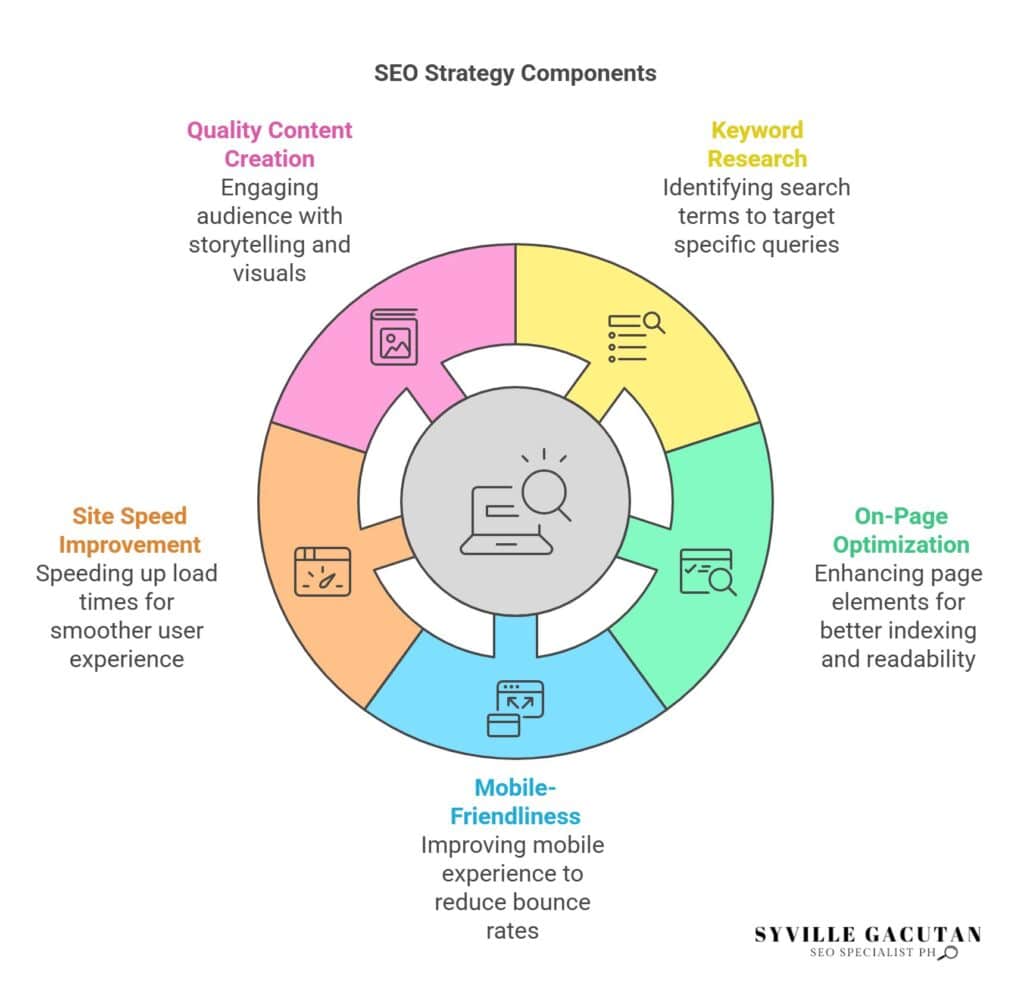
Essential SEO Checklist for Small Business Websites
If you want to increase your small business website’s online visibility and keep visitors engaged, here’s a simple yet effective SEO checklist to follow. Start by researching the keywords your customers are using, focusing on more specific long-tail keywords that will help you stand out. Use tools like Google Keyword Planner to guide you. Next, optimize your website by tweaking things like meta tags and headers, making it easier for both search engines and people to understand. Ensure your site looks great on mobile devices and loads quickly—nobody likes waiting for a slow website! High-quality, helpful content is a must—write with your customers in mind, answering their questions and solving their problems. Don’t forget about local SEO—make sure your Google My Business profile is updated so people can easily find you in local searches. Building relationships with other websites to gain quality backlinks will also help boost your credibility. Finally, keep track of your progress by regularly reviewing your site’s performance and staying up to date with SEO best practices. This way, you’ll always be ready to adjust and keep improving with this on-page SEO checklist for small businesses.
Key Takeaways
- Conduct keyword research: Identify the search terms your potential customers are using, especially focusing on long-tail keywords with lower competition to capture more specific queries.
- Optimize on-page elements: Ensure that title tags, meta descriptions, and header structures are clear, engaging, and easy for search engines to index, while improving readability for visitors.
- Enhance mobile-friendliness: Use responsive design and touch-friendly navigation to provide a better experience on mobile devices, reducing bounce rates and increasing engagement.
- Improve site speed: Optimize images, use caching methods, and implement a Content Delivery Network (CDN) to speed up load times and create a smoother user experience.
- Create quality content: Engage your audience by using storytelling and incorporating visual elements, building trust, and encouraging them to stay on your site longer.

Keyword Research
Embarking on the journey of keyword research is crucial for small businesses aiming to enhance their online visibility. This foundational step in search engine optimization (SEO) helps identify the specific terms and phrases potential customers use when searching for products or services.
Focusing on long tail keywords is especially beneficial for small businesses, as these are typically more specific and less competitive, making it easier to rank higher on search engine results pages (SERPs).
To effectively conduct keyword research, utilizing various keyword tools is essential. These tools, such as Google Keyword Planner and SEMrush, provide insights into search volume, competition, and related terms, allowing businesses to strategically select the most relevant keywords.
Incorporating competitor analysis into your research process is another critical aspect. By examining the keywords that competitors are targeting, small businesses can identify gaps and opportunities to differentiate their offerings and capture untapped market segments.
Understanding search intent is also vital. It involves discerning why users are searching for specific keywords, whether it’s for informational, navigational, transactional, or commercial purposes. This understanding helps in choosing keywords that align with the content’s purpose and the users’ needs, ultimately improving the chances of conversion.
Lastly, keyword placement plays a pivotal role in maximizing the effectiveness of your chosen keywords. Ensuring that these keywords are strategically placed within website content, such as in titles, headings, and meta descriptions, is crucial for both search engines and users.
On-Page Optimization
When it comes to enhancing a small business website’s SEO performance, on-page optimization is a critical element that cannot be overlooked. This process involves refining individual web pages to achieve higher rankings and attract relevant traffic from search engines. A well-executed on-page strategy ensures that both users and search engines can understand your content clearly.
The starting point for effective on-page optimization is crafting compelling meta tags. These include the title tags and meta descriptions that provide a brief summary of the page content. Accurate and engaging meta tags can significantly influence click-through rates, making them indispensable for SEO success.
Equally important are header tags, which organize content hierarchically and enhance readability. Proper usage of header tags (H1, H2, H3, etc.) not only helps search engines comprehend the page’s structure but also aids users in navigating through the text efficiently.
Image optimization is another pivotal aspect of on-page SEO. By compressing images without sacrificing quality and using descriptive filenames and alt attributes, you can improve page load times and enhance accessibility, both of which are critical to retaining visitors and boosting rankings.
Moreover, internal linking within your website ensures a seamless user experience and allows search engines to discover and index additional pages. Thoughtfully placed internal links can guide users to related content, improving site engagement and decreasing bounce rates.
Lastly, a clean and descriptive URL structure is essential. URLs should be concise, keyword-rich, and reflect the page’s content, aiding both users and search engines in understanding the page’s relevance and context.
Mobile Friendliness

How crucial is mobile friendliness in today’s digital landscape? With over half of global web traffic coming from mobile devices, ensuring your small business website is mobile-friendly is not just an option but a necessity.
A responsive design is the cornerstone of mobile friendliness, allowing your website to adapt seamlessly to various screen sizes and orientations. This adaptability ensures that users receive a consistent experience, regardless of the device they are using.
Mobile usability goes hand in hand with responsive design. It refers to how easily users can navigate and interact with your site on their mobile devices. This includes optimizing touch elements, such as buttons and links, to ensure they are easily tappable without causing frustration.
Touch optimization is vital; it enhances the user’s ability to engage with your content, thus reducing bounce rates and increasing conversions.
Google’s move to mobile indexing further underscores the importance of mobile friendliness. Mobile indexing means that Google predominantly uses the mobile version of your site for ranking and indexing. Therefore, a site that performs well on mobile devices is more likely to rank higher on search engine results pages.
Moreover, app integration can enhance mobile usability by providing additional functionalities and a more streamlined user experience. Whether through a dedicated app or a web-based app-like experience, integrating these features can significantly enhance user engagement.
Site Speed Improvement

In today’s fast-paced digital world, a website’s speed is a critical factor in retaining visitors and enhancing user experience. For small businesses, ensuring optimal site performance is essential for maintaining a competitive edge. One of the most effective ways to achieve this is through image optimization. By compressing images and using appropriate file formats, businesses can significantly reduce loading times, leading to faster page speeds.
Another crucial technique is implementing browser caching. This allows previously loaded resources to be stored in a visitor’s browser, reducing the need for repeated server requests and thereby speeding up the load time for returning visitors.
Additionally, improving server response times can drastically enhance overall site speed. This can be achieved by optimizing databases, using efficient server configurations, and upgrading hosting services if necessary.
CDN integration, or Content Delivery Network, is another powerful strategy for boosting site speed. By distributing website content across multiple geographically dispersed servers, a CDN ensures faster and more reliable data delivery to users, regardless of their location. This not only enhances speed but also increases site reliability and resilience against traffic spikes.
Finally, performance monitoring is vital for continuous improvement. Tools like Google PageSpeed Insights or GTmetrix provide valuable insights into a website’s speed, offering actionable recommendations for optimization. Regular monitoring helps identify and rectify performance bottlenecks, ensuring that the website remains fast and efficient.
Incorporating these strategies into your SEO checklist will not only improve site speed but also contribute positively to user satisfaction and search engine rankings, essential for small business success.
Quality Content Creation

While optimizing site speed is a vital aspect of enhancing user experience, creating quality content is equally important in capturing and retaining the attention of your audience.
In the realm of content marketing, the focus should be on delivering value through meaningful, relevant, and engaging materials that resonate with your target market. Quality content not only enhances SEO but also strengthens customer relationships and brand loyalty.
To effectively execute content marketing, consider these three essential strategies:
- Audience Targeting: Understand who your audience is and what they seek. Tailor your content to address their needs, preferences, and pain points. This requires thorough research and analytics to develop a clear profile of your audience, enabling you to craft messages that speak directly to them.
- Brand Storytelling: Leverage the power of narrative to convey your brand’s mission, values, and personality. Storytelling humanizes your brand, making it relatable and memorable. Through compelling stories, you can differentiate your business in a crowded market and forge a deeper connection with your audience.
- Visual Content: Incorporate images, videos, infographics, and other visual elements to enhance engagement and improve information retention. Visual content is more likely to be shared on social media, boosting your reach and visibility. It breaks up text and adds a dynamic layer to your content, making it more appealing.
Furthermore, encourage social sharing by making content easily shareable and engaging. This not only increases your reach but also enhances your search engine ranking.
Local SEO Strategies

A significant portion of online searches today are localized, making local SEO strategies essential for small businesses aiming to capture local clientele and increase foot traffic. Integrating local SEO techniques can significantly enhance visibility and engagement in your community. One of the first steps is optimizing your Google My Business profile, ensuring that all business details are accurate and complete. This includes your business name, address, phone number, and operating hours. Regular updates and engaging posts can further improve your local search presence.
Local citations also play a critical role. These are mentions of your business on other websites, even if there is no direct link back to your site. Ensuring consistency across all platforms, from Yelp to local directories, can help search engines verify your business information, boosting your local rankings.
Customer reviews are another vital aspect of local SEO. Encouraging satisfied customers to leave positive reviews not only enhances credibility but also impacts your search rankings. Responding to reviews, both positive and negative, demonstrates your commitment to customer satisfaction.
Utilizing schema markup can further refine your local SEO efforts. This structured data helps search engines understand your website’s content, improving the way your business appears in search results. Additionally, effective location targeting in your content and advertising can ensure your business reaches the right audience.
Here’s a breakdown of these strategies:
| Strategy | Importance | Action Required |
| Google My Business | Boosts visibility | Regular updates and accurate info |
| Local Citations | Verifies business information | Consistency across platforms |
| Customer Reviews | Enhances credibility and search rankings | Encourage and respond to reviews |
Implementing these local SEO strategies can significantly benefit small businesses by increasing their local search presence and driving more targeted traffic.
Backlink Building

Having established a strong local SEO foundation, attention now shifts to backlink building—a fundamental aspect of broader search engine optimization. Backlinks, essentially inbound links from other reputable websites, serve as endorsements for your small business’s website, enhancing its authority and visibility in search engine results.
To effectively harness the power of backlinks, small businesses should consider a multi-pronged approach.
- Guest Posting: Contributing quality content to relevant blogs and websites not only positions your business as an industry thought leader but also provides valuable backlinks. Crafting insightful articles that resonate with the target audience can lead to natural link-building opportunities and expanded reach.
- Link Exchanges and Influencer Outreach: Establishing mutually beneficial partnerships through link exchanges can be fruitful. However, it is crucial to engage with credible partners to maintain link integrity. Engaging in influencer outreach can amplify your brand’s message, as influencers often have established networks that can drive traffic and generate high-quality backlinks.
- Directory Submissions and Content Syndication: Submitting your business to relevant online directories enhances its online footprint. While directory submissions should be approached judiciously, they can still provide valuable backlinks. Content syndication, where your content is republished by reputable platforms, can further extend its reach and backlink profile.
Incorporating these strategies into your SEO checklist ensures a comprehensive approach to backlink building. By leveraging guest posting, link exchanges, and influencer outreach, alongside directory submissions and content syndication, small businesses can significantly enhance their online presence and authority.
This strategic backlink-building approach is pivotal for achieving sustainable growth and visibility in the competitive digital landscape.
User Experience Enhancement

To truly succeed in the digital marketplace, enhancing user experience on your small business website is paramount. A seamless user interface not only retains visitors but also boosts conversion rates and brand loyalty. Central to improving user experience is the active collection and analysis of user feedback. By understanding the needs and preferences of your audience, you can make informed adjustments to your website’s design and functionality.
Design consistency plays a crucial role in establishing a professional and trustworthy appearance. Ensure that your site’s visual elements, such as color schemes, fonts, and layouts, are uniform across all pages. This consistency helps in building brand recognition and provides a cohesive experience for users navigating your site.
Navigation simplicity is another key component. Users should be able to find what they need without unnecessary clicks or confusion. Implement a clear and intuitive menu structure that guides users effortlessly to your content. Additionally, strategically placed call to action elements can direct visitors toward desired actions, such as making a purchase or signing up for a newsletter, thereby enhancing engagement and conversions.
Incorporating accessibility features is essential in making your website usable for everyone, including those with disabilities. Utilize alt text for images, provide keyboard navigation options, and ensure that your site is compatible with screen readers.
These features not only broaden your audience reach but also demonstrate a commitment to inclusivity and social responsibility.
Regular SEO Audits

Enhancing user experience is just one piece of the puzzle for optimizing your small business website; another critical component is conducting regular SEO audits. These audits are essential for maintaining the health of your website and ensuring it remains competitive in the ever-evolving digital landscape. They help identify weaknesses and opportunities, providing a roadmap for improving your site’s search engine performance.
To conduct an effective SEO audit, consider the following key elements:
- SEO Tools: Utilize modern SEO tools to gather comprehensive data on your website’s performance. Tools such as Google Analytics and SEMrush can offer insights into keyword rankings, backlinks, and overall site health.
These tools provide actionable insights, allowing you to address technical issues and enhance your site’s visibility.
- Competitor Analysis: Regularly analyze your competitors’ strategies. Understanding what works for them can reveal content gaps on your own site and highlight areas for improvement.
By examining their keyword usage, backlink profiles, and user engagement strategies, you can adapt and refine your approach to maintain a competitive edge.
- Algorithm Updates: Stay informed about search engine algorithm updates, as these can significantly impact your website’s ranking.
Regular audits enable you to ensure compliance with the latest guidelines and adjust your SEO strategies accordingly. This proactive approach minimizes the risk of penalties and maintains your site’s search engine visibility.
Incorporating these practices into your routine will help you stay ahead in the digital marketing arena. Regular SEO audits, combined with consistent analytics tracking, ensure your website remains optimized and aligned with industry standards.
Final Thoughts
A well-rounded SEO strategy is essential for small businesses looking to enhance their online visibility and stay competitive in today’s digital landscape. By focusing on crucial areas such as keyword research, on-page optimization, mobile-friendliness, site speed, and quality content creation, businesses can significantly improve their search engine rankings and user experience. Regular audits and updates, along with leveraging local SEO and backlink strategies, will ensure sustained growth and adaptability. By implementing these strategies and continuously monitoring performance, small business websites can build a strong online presence and attract more targeted traffic, ultimately leading to better customer engagement and increased conversions.
Need expert help optimizing your small business website for SEO success? Connect with Syville Gacutan, an experienced SEO Specialist in the Philippines. Syville can help you boost your online visibility, enhance user experience, and drive more traffic to your site. Contact today and start growing your business with proven SEO strategies!